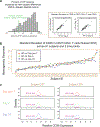Systematic Analysis of Cell-to-Cell Expression Variation of T Lymphocytes in a Human Cohort Identifies Aging and Genetic Associations
- PMID: 27851916
- PMCID: PMC6532399
- DOI: 10.1016/j.immuni.2016.10.025
Systematic Analysis of Cell-to-Cell Expression Variation of T Lymphocytes in a Human Cohort Identifies Aging and Genetic Associations
Abstract
Cell-to-cell expression variation (CEV) is a prevalent feature of even well-defined cell populations, but its functions, particularly at the organismal level, are not well understood. Using single-cell data obtained via high-dimensional flow cytometry of T cells as a model, we introduce an analysis framework for quantifying CEV in primary cell populations and studying its functional associations in human cohorts. Analyses of 840 CEV phenotypes spanning multiple baseline measurements of 14 proteins in 28 T cell subpopulations suggest that the quantitative extent of CEV can exhibit substantial subject-to-subject differences and yet remain stable within healthy individuals over months. We linked CEV to age and disease-associated genetic polymorphisms, thus implicating CEV as a biomarker of aging and disease susceptibility and suggesting that it might play an important role in health and disease. Our dataset, interactive figures, and software for computing CEV with flow cytometry data provide a resource for exploring CEV functions.
Published by Elsevier Inc.
Figures






Comment in
-
Expression Diversity Adds Richness to T Cell Populations.Immunity. 2016 Nov 15;45(5):960-962. doi: 10.1016/j.immuni.2016.10.019. Immunity. 2016. PMID: 27851924
References
-
- Acar M, Mettetal JT, and van Oudenaarden A (2008). Stochastic switching as a survival strategy in fluctuating environments. Nat. Genet 40, 471–475. - PubMed
-
- Agius E, Lacy KE, Vukmanovic-Stejic M, Jagger AL, Papageorgiou A-P, Hall S, Reed JR, Curnow SJ, Fuentes-Duculan J, Buckley CD, et al. (2009). Decreased TNF-α synthesis by macrophages restricts cutaneous immunosurveillance by memory CD4+ T cells during aging. J. Exp. Med 206, 1929–1940. - PMC - PubMed
Publication types
MeSH terms
Grants and funding
LinkOut - more resources
Full Text Sources
Other Literature Sources
Medical

